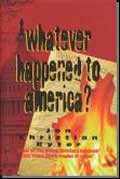A VALUABLE NEW BOOK ON THE KGB
By
Herbert Romerstein
May
16, 2009
NewsWithViews.com
The new book, Spies, The Rise and Fall of the KGB in America by John Earl Haynes, Harvey Klehr, and Alexander Vassiliev (Yale University Press, New Haven & London, 2009) provides us with valuable new information about how the KGB penetrated the United States government in the 1930s and 40s. It supplements our earlier information, including the Venona intercepts (Soviet intelligence communications between the U.S. and Moscow during World War II, on the website of the National Security Agency); the FBI files on their lengthy investigation of the interrelationship between the KGB and the American Communist Party in the 1930s and for many years later (on the website of Stan Evans’ Education & Research Institute); and the extensive work on Soviet espionage of the House Committee on Un-American Activities, the Senate Subcommittee on Internal Security, and the Senate Permanent Investigation Subcommittee of Senator Joseph McCarthy. The printed transcripts of Senate and House hearings can be found at any good library.
The Haynes, Klehr, Vassiliev book is based on the files that former KGB officer Vassiliev copied and summarized in Moscow in the mid-1990s. His handwritten notes of the files he was allowed to see are an important addition to the earlier investigations.
In 1992, before Vassiliev was picked by KGB, a meeting was held at the Watergate in Washington, DC. The host for the meeting was Walter Pforzheimer, retired general counsel of CIA. Attending the meeting were two serving KGB officers, Oleg Tsarev and Yuri Kobaladze, a few American specialists in KGB history and representatives of Random House and its subsidiary Crown Books. A deal was being arranged between Crown Books and the veterans’ organization of the KGB. Tsarev and Kobaladze, although still serving KGB officers, represented the veterans’ organization in the negotiations.
A Meeting With the KGB
I was one of those lucky enough to be invited to the Watergate meeting. It wasn’t long before Pforzheimer was mad at me because he felt I was “mean” to our Soviet guests. The two KGB officers didn’t think so; I knew them from before and had extensive contact with them since. Kobaladze later retired as a KGB general after both he and Tsarev served in a number of KGB overseas posts. Tsarev explained at the Watergate meeting that even before the collapse of the Soviet Union, the head of KGB, Vladimir Kryuchkov, had decided to improve the image of the Soviet Intelligence Service. Selected materials from KGB archives would be made available to one Russian and one foreign writer to write about KGB history and successes.
My complaint at the meeting was that the foreign co-author would not get to see any KGB material, whereas in any good archive we could see the documents in context and could better understand what the KGB was up to. I soon learned that in most cases, even the Russian co-author would only be shown a few selected files. Those files would be picked out by KGB researchers. The Russian author would then turn his notes over to Kobaladze, who kept the files in the KGB press office in Moscow. That made me more unhappy, because we would have to trust the honesty of the Russian co-author.
Vassiliev says that he never showed his notebooks to Kobaladze who had the power to delete portions. In reality, Vassiliev was more trustworthy than I assumed. His notebooks, which are now on the website of the Cold War International History Project, became the basis for the new book written by Haynes and Klehr. What is more important is that much of the material is consistent with the intercepted Soviet Intelligence communications in Venona and of the extensive investigations by the FBI and the security committees in Congress. What Vassiliev’s notebooks add is the identification of some of the spies and agents of influence. In some cases, all we had was their KGB code names?we now also have real names. What Vassiliev did not see was KGB files from other sections and Soviet Military Intelligence files. We are able to identify some of the agents because the files were so jumbled that pieces from other files showed up in the ones that Vassiliev saw.
In 1992, I asked Tsarev to find a letter for me in the KGB files. Harvey Klehr had found a note in the files of the Communist International that Earl Browder, head of the American Communist Party, had sent to George Dimitrov, head of the Comintern. Browder requested that his sister, Margaret Browder, be released of her assignment working for Soviet Intelligence, because if that were revealed it would be embarrassing. Browder’s letter had been sent to Beria, Stalin’s murderer-in-chief, and no copy was left in the Comintern archives. Tsarev found the letter for me and sent it along with a letter of apology saying that it took a year to find because KGB files were in such disorder. When Harvey Klehr returned from Moscow, he shared with me the documents he had obtained. When I received the Margaret Browder letter from KGB, I shared it with Klehr and Haynes. Their book The Secret World of American Communism was soon to come out and my book on Venona, exposing Soviet espionage and America’s traitors (Regnery, Washington DC, 2000) would not come out for a few years.
There were two chiefs of Soviet Intelligence in the United States during World War II. One was Vassiliy Zarubin, head of the “legal” station. The other was Iskhak Akhmerov, head of the “illegal” station. The difference was that Zarubin was employed at the Soviet Embassy as Third, later Second Secretary and had diplomatic immunity. Akhmerov pretended to be an American and had an American birth certificate and passport, which had been illegally secured for him in 1934. He even registered for the draft under the pseudonym William Grienke, the name on his birth certificate. He had a fur and clothing business in Baltimore as a cover. The Americans he met were not supposed to pay attention to his Russian accent but to concentrate on his Iowa-born wife. She was the niece of Communist Party leader Earl Browder and in 1945 returned with Akhmerov to Moscow with their baby daughter.
Akhmerov had a son by an earlier marriage named Robert Akhmerov. When I phoned Kobaladze in Moscow, I wanted to find Robert. He asked, was he a KGB officer? I answered yes, he served in Africa. A few nights later Kobaladze expressed regrets that Robert had apparently died of alcoholism and asked whether I would want to speak to Elena, the daughter of Iskhak and Helen Akhmerov. Of course, I did; Elena, who worked for KGB, was the daughter born in the United States. But a few nights later Kobaladze said she refused to talk to me.
Vassiliev never saw the files of Akhmerov’s “illegal” KGB station (illegal rezidentura). But, since Akhmerov sometimes used Zarubin’s communication facilities, the code word “Yunga” (Jung) does show up in Zarubin’s files. Akhmerov contacted some of the most sensitive KGB spies. The top secret KGB textbook used in their internal school in 1977 says, “The rezidentura ‘Yunga’ transmitted more than 2500 Photostats of documents obtained directly in leading governmental institutions in the U.S.A.” Vassiliev saw none of those documents. From Congressional testimony and other sources we know that some of them were shipped back to Moscow on microfilm carried by American communists working as merchant seamen. Other documents were packaged and sent to Moscow in Lend Lease shipments that American customs was not permitted to open.
Journalistic Icon I.F. Stone
Haynes and Klehr identify the writer I.F. Stone as an agent of NKVD, the earlier name of KGB. According to Vassiliev’s “Black Notebook” (page 23), Stone with the code name “pancake” had entered “the channel of normal operational work.” In other words, Stone had agreed to take directions from the Soviet Secret Police. However, Haynes and Klehr say that Stone was not a member of the Communist Party where the Soviets recruited most of the agents. They drew this conclusion because the Vassiliev material did not refer to him as a Communist Party member. The FBI, however, reported two sources who revealed I.F. Stone’s Communist Party membership. We have identified one of them as Louis Budenz, former editor of The Daily Worker, who later became an active anti-communist. In Vassiliev’s notebooks, we learn that the same NKVD agent Frank Palmer recruited both Budenz and Stone for Soviet Intelligence (Vassiliev “Black Notebook,” pages 10 and 23). Budenz’s main work for the KGB was to assign Communist Party members to infiltrate the Trotskyist organization.
It is a little unfair for Haynes and Klehr to simply refer to those controlled by Soviet intelligence as “spies.” Some did spy on other Americans, or tried to influence policy, acted as couriers or as recruiters. Some played more than one role.
One of the defects of the book is that although it’s a good account of some of Vassiliev’s revelations, and even uses some earlier FBI and committee information which are mentioned in the footnotes, there is no praise for their extensive investigations by Klehr and Haynes.
Senator McCarthy’s Charges
On March 18, 1950, Senator Joseph McCarthy sent a letter to Millard Tydings, Chairman of the Senate Foreign Relations Subcommittee investigating McCarthy’s charges. When M. Stanton Evans wrote his book (Blacklisted By History, The Untold Story of Senator Joe McCarthy and His Fight Against America’s Enemies, Crown Forum, New York, 2007), that document was missing from the Tydings files in the National Archives. Evans finally tracked it down in McCarthy’s own papers. In addition to many of the people listed by both McCarthy and in the book by Haynes and Klehr, two names stand out: Stanley Graze and Franz Neumann. Both were NKVD (KGB) sources in the OSS, the predecessor of CIA. McCarthy had spotted them and identified them to Senator Tydings 59 years before they were exposed by Klehr and Haynes.
The OSS even tried to work out an information sharing relationship with the NKVD. A February 10, 1944 letter from the FBI’s J. Edgar Hoover to Harry Hopkins for President Roosevelt complained that “a liaison arrangement has been perfected between the Office of Strategic Services and the Soviet Secret Police (NKVD).” According to Vassiliev’s “White Notebook #1” (page 87), Akhmerov had reported that “Hoover has objected to the OSS agreement with Moscow in a letter to Hopkins that was passed along to Roosevelt and sent to the Joint Chiefs of Staff. The USSR’s objective is to get into state secrets.” However, the American “powers that be” said they saw no grounds to alter the OSS-NKVD agreement. Nevertheless Akhmerov “warns that Hoover will interfere with cooperation” according to the Vassiliev notes. A later listing of documents showed that the OSS had supplied the Soviets with “lists of its operatives in territory occupied by the Soviet Army” (“White Notebook #1” page 105).
In the 1980s, Oleg Gordievsky, who had served as a British undercover agent in the KGB, reported shocking news to his British handlers. When he was a young officer, Gordievsky attended a lecture given by Iskhak Akhmerov. According to the KGB official, Akhmerov called Hopkins “the most important of all Soviet war-time agents in the United States” [and] “the closest and most trusted advisor of President Roosevelt.” When Gordievsky discussed this with other KGB officers, “All were agreed that Hopkins had been an agent of major significance.” The British Intelligence Service, MI6, decided after Gordievsky escaped from the Soviet Union, to have him write a book with the British academic Christopher Andrew (KGB: The Inside Story, Christopher Andrew and Oleg Gordievsky, Harper Collins, 1990, page 287). Andrew concluded that Hopkins was an “unconscious” agent.
When I spoke with Gordievsky, in 1995, we agreed that the Venona message reporting on a conversation with only Roosevelt, Truman, and a third person present had to come from Hopkins. Akhmerov was exactly right. J. Edgar Hoover did not know the evidence against Hopkins when he wrote the letter.
KGB Defector Mitrokhin
In 1999, the British made another KGB defector available to Christopher Andrew. Vasiliy Mitrokhin had spent 12 years as a KGB researcher and had taken extensive notes from all of the KGB archives. He then escaped to Great Britain and his material was smuggled out of Russia. Most of the Mitrokhin material, except that which was given to Christopher Andrew, is unavailable to researchers in the West. The British shared the material related to each country with all of their allies. The large collection made available to the government of Italy was released to the public by the Italians. Most of it relates to post-World War II, but a large number of Soviet agents are identified.
Mitrokhin had some interesting information about Harry Hopkins also. J. Edgar Hoover had reported to Hopkins for Roosevelt, “Through a highly confidential and reliable source it has been determined that on April 10, 1943, a Russian who is an agent of the Communist International paid a sum of money to Steve Nelson, National Committeeman of the Communist Party, USA, at the latter’s home in Oakland, California. The money was reportedly paid to Nelson for the purpose of placing Communist Party members and Comintern agents in industries engaged in secret war production for the United States Government so that information could be obtained for transmittal to the Soviet Union.” We have now found a copy of this Hoover letter in the Hopkins papers at the Roosevelt Library in Hyde Park, New York. The FBI letter identified the Russian as Vasili Zubilin. We now know from Congressional investigations that he was Vasili Zarubin, the NKVD chief in the United States. Hoover said in his letter to Hopkins and Roosevelt, “Because of the relationship demonstrated in this investigation between the Communist Party, USA, the Communist International and the Soviet Government, I thought the President and you would be interested in these data. These matters are being brought to your attention at this time for your confidential information inasmuch as the investigation is continuing.” The information was so sensitive because it revealed that the FBI had a microphone in Communist leader Steve Nelson’s home and could record all of his conversations.
Mitrokhin’s shocking report was that the sensitive information was immediately passed by Hopkins to the Russians. Christopher Andrew concluded that Hopkins was “an American patriot” and that Roosevelt had ordered Hopkins to give the Soviets the information. There is no evidence of that. The only evidence is that Hopkins gave the sensitive information to the Soviets which allowed them to take precautions against the United States learning more about Soviet espionage.
Sometimes Vassiliev, not understanding the import of the information, left out an essential clause in a document. For example, Vassiliev reported that Julius Rosenberg, the Soviet spy, “recommended Ruth Greenglass, his wife’s brother’s wife” to take over a safe house for the NKVD. Vassiliev reported according to Julius Rosenberg, Ruth was “an able and smart young woman.” In this case, we have the actual cable from the Venona intercepts released by the U.S. government. This said that Rosenberg and his wife “recommend her as an intelligent and clever girl.” Vassiliev left out the phrase about Julius Rosenberg’s wife, who was executed with him. The Soviets got recommendations for spies only from other spies. Vassiliev’s error provided an opportunity for the left to claim that Ethel Rosenberg was innocent when this report reveals she was deeply involved in her husband’s spying.
A number of the agents in atomic espionage other than Julius and Ethel Rosenberg were handled by Soviet Military Intelligence, the GRU. There are references to some of these people in Zarubin’s archive but the NKVD was warned to leave them alone as the GRU was running them. In addition to the GRU and Akhmerov archives, Vassiliev was not allowed to see the folders on atomic espionage. They were given to another KGB officer, who made such a cat’s breakfast out of them that they are useless in identifying agents. The book never appeared in English. At this point only the KGB has seen those folders.
|
Subscribe to the NewsWithViews Daily News Alerts! |
All in all, the Haynes-Klehr book is worth reading, mainly for what it does say. We will have to wait for the other shoe to drop to learn more about the KGB. The other shoe is the vast collection of Mitrokhin material that has not been released by the British. Although some MI5 security files have been released in Britain to their National Archives, we can only hope that the Mitrokhin material, like Venona, will not take another 50 years to be released by the British.
� 2009 - Herbert Romerstein - All Rights Reserved













